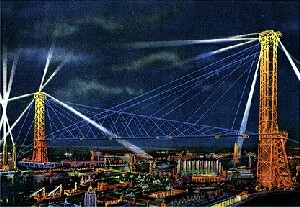|
The Chicago World Exposition 1933 & 1934
|
Year: | 1933 | | City: | Chicago | | Country: | USA | | Duration: | 27th May - 12th November 1933 und 25th M |
|
1
| 
Copyright: |
|
Comments
Benjamin F. Betts: Reflections on a Century of Progress
The Century of Progress in Chicago impresses one with the great advance made in scientific developments during the past one hundred years. Science has provided for the building field new structural materials; scraps once wasted have been made useful; natural resources have been tapped to provide new and valuable products. Man, ever mindful of comfort and convenience, has harnessed nature's forces and produced controlled power, warmth, cold, weather, acoustics and light. Accomplishments in these directions have come largely in the last third of the century. (...)
The buildings of the Chicago exposition, influenced in their design by the "modern" school, crystallize an epoch in architectural history. That they represent a transitional period is evidenced by the wide divergence of opinion as to whether or not they are "good architecture". These buildings contrasted with the exposition's reproductions of Fort Dearborn and the birthplace of Lincoln, vividly remind us of the part science now plays in architecture and building. The real century of progress in architecture has only began.
Source: American Architect, Volume 143, July 1933, page 9.
Arthur F. Woltersdorf: Carnival Architecture
These colors cut in and out of the same building so that disintegration of design rather than harmony is produced. The Federal and States Building (Edward H. Bennett, architect) is perhaps more carefully colored for unity of design than is the Hall of Science, and yet the black stylobate of the Federal Building makes this structure float in some lights where the black disappears.
Mr. Urban is best known in this country through his brilliant stage sets, notably those of the Ziegfeld Follies. The problem here would seem to be different, with changing skies and water as a background. The black, heavy reds and dark blues of the Electrical Group seem almost barbaric; while across the lagoon the coloration of the white Hall of Science seems insipid. Its blue bands, cut into by boxes of bright yellow against a wall of saffron and the treatment of the tower - with east and north faces in two shades of blue, and west and south faces, white - disorganize the design of the building.
Source: American Architect. Volume 143, July 1933, pages 10-21, here page 13.
Louis Skidmore: Planning the Exposition Displays
The Century of Progress Exposition is based on an idea - that of science as the determining factor in the progress of the past hundred years. Thus the exhibitors have a foundation for their displays and the architects a logical problem on which to base the building designs. The result is an ensemble of closely-knit structures, flexible in extent, with great halls for special features at salient points between connecting units of required lower ceiling height giving the proper size cubicles demanded by the exhibitors.
The exposition's exhibit of basic sciences in the Hall of Science established a nucleus around which the commercial exhibitors could build their displays. From the Hall of Science will radiate the eighty miles of exhibits. All of these exhibits are architecture, "the science of building", from the gigantic electric locomotive to the microscopic cell structures. They will be well studied: in operation, in full size or model, in animated or in diorama (a three-dimensional picture) form. They will demonstrate the service to mankind of an industry or a science, its processes, research, historical background and development.
Source: Architectural Record.
Volume 73, May 1933, pages 345 ff., here page 345.
|



